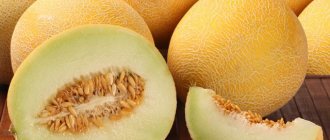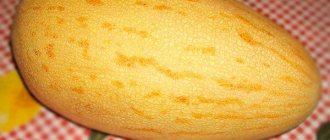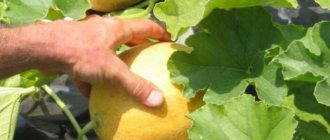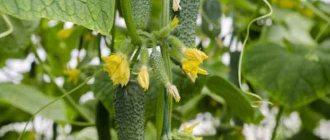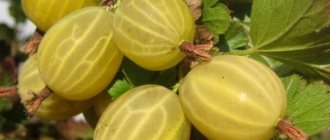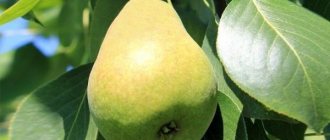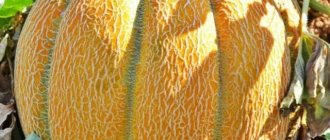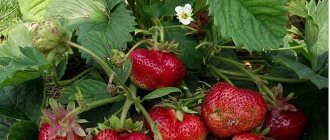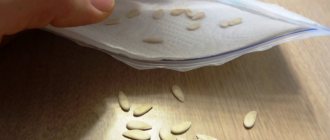“Torpedo” is considered one of the best varieties of melons. It is easily recognized by its impressive size, oblong shape and rich melon aroma. Despite its Uzbek roots, Torpedo is growing well in Russia. Let's learn how to plant and grow Uzbek melon in a temperate climate.
melon variety “Torpedo”
melon “Torpedo” juicy and sweet to the very crust
The ripe Torpedo melon spreads a delicious, sweetish aroma
Description of Torpedo melon
Varietal characteristics of “Torpedo”:
- oblong-shaped fruits;
- the crust is yellow, mottled with thin silvery veins;
- the pulp is white, juicy, has an oily consistency, thickness – 5-6 cm;
- There are many seeds inside the fruit.
The stems are strong and powerful. The shoots reach 2 m in length - they can be tied to supports.
"Torpeda", grown in Uzbekistan, has fruits up to half a meter in length.
Ripe Torpedo is easy to recognize by its aroma. This variety is characterized by increased aroma - the fruit exudes a specific melon aroma - delicate and sweetish.
Main characteristics
Fruits grown in temperate climates are smaller in weight and size than Uzbek “Torpedoes”. They are also inferior in taste to fruits grown in Asia.
Main characteristics of Torpedo melon:
| Characteristics/parameters | Description/meaning |
| Ripening time | late ripening, ripens no earlier than August |
| Achieving technical maturity | 60 days |
| Fruit weight | in Uzbekistan – up to 15 kg, in Russia – up to 5-7 kg |
| Transportability | excellent |
| Taste | excellent (but with a lack of sun the taste deteriorates) |
| Aroma | bright, rich, combines notes of pineapple, duchess and vanilla |
Fruits grown without harmful chemicals appear on the market no earlier than the end of August. Until this time, you should not buy oblong melons - they are either unripe or saturated with harmful additives that stimulate the growth of the crop.
An overview of the melon variety “Torpedo” is presented in the following video:
Chemical composition and beneficial properties of melon
A popular seasonal vegetable in Russia, it is a source of many valuable substances, mineral salts and vitamins. “Torpedo” replenishes the lack of nutrients, gives slimness and health.
This is a dietary product, it contains only 55 kilocalories for every 100 grams and almost 13% of the daily value of fiber. Melon has high nutritional value. When consumed regularly, it has a healing effect on the entire body:
- stimulates metabolic processes,
- improves blood composition,
- promotes the production of serotonin,
- strengthens the immune system,
- removes excess fluid
- eliminates toxins,
- lowers cholesterol,
- gives a sedative effect.
The fruits are recommended for elderly patients suffering from atherosclerosis. They are used as a mild laxative and included in the diet for anemia, liver and cardiovascular diseases.
The sweet, enchanting aroma and rich taste of “Torpedo” is due to its chemical composition. Melon is 90% water, but the remaining 10% is a real treasure trove of benefits! Enzymes, organic acids, pectin - all this has a beneficial effect on health.
The vitamin composition is presented in the table.
| Name | Amount, mg | % Daily Value |
| Beta carotene | 0,4 | 8 |
| B1 | 0,04 | 2,7 |
| B2 | 0,04 | 2,2 |
| B4 | 7,6 | 1,5 |
| B6 | 0,23 | 4,6 |
| B9 | 0,06 | 3 |
| C | 20 | 22,2 |
| E | 0,1 | 0,7 |
| K | 0,29 | 2,4 |
| PP | 0,5 | 2,5 |
Many authors note the importance of folic acid in ripe melon, but this is at odds with the data in the reference tables. Three percent of the daily value is nothing. Instead, eat mung beans, peanuts and avocados. They contain 20-50 times more vitamin B9.
Sugars here are “fast” and lead to sharp jumps in blood glucose. Diabetics should take this into account.
Mineral composition
“Torpedo”, like other varieties of melons, contains mineral salts of the most important chemical elements. Not all of them are present in sufficient quantities, but some positions are very pleasing.
| Mineral | Amount, mg | % daily requirement |
| Potassium | 118 | 4,7 |
| Silicon | 82 | 273,3 |
| Magnesium | 13 | 3,3 |
| Iron | 1 | 5,6 |
| Iodine | 0,2 | 1,3 |
| Cobalt | 0,2 | 20 |
| Copper | 4,7 | 4,7 |
| Selenium | 0,07 | 1,3 |
| Chromium | 0,2 | 4 |
Notice the overwhelming amount of silicon. In terms of its content, the product is ahead of corn, peanuts, avocado, second only to pineapple and some cereals - egg, brown rice, buckwheat.
The importance of Si for health is difficult to overestimate. It is the main element of collagen fibrils, which form the basis of connective tissue. Collagen fibers determine the elasticity of tendons, intestinal walls, blood vessels, heart valves and gastrointestinal sphincters.
Most deviations in the condition of the skin, hair and nails indicate a lack of silicon. The element is concentrated in the dermis, thyroid gland, and lymph nodes. It is involved in the metabolism of vitamins and mineral salts.
Advantages and disadvantages
Advantages:
- The fruits are well transported - melons can be transported over long distances without any problems.
- It can be grown not only in the south of Russia, but also in regions with a temperate climate.
- The fruits have remarkable product and taste characteristics.
- The fruits can be stored for a long time. In the basement or just in a cool room, “Torpedoes” can remain fresh and tasty until spring.
This wonderful variety has one drawback - the plant is demanding on growing conditions.
“Torpedo” needs warmth, and even better – sun, a lot of sun. This is what makes it so difficult to grow truly sweet melons in mid-latitudes. Unlike its main competitor, Kolkhoznitsa, it is not able to ripen completely in a temperate climate, and therefore does not reveal its true taste.
Possible harm and contraindications for use
Despite all the benefits, torpedo melon can cause health problems if consumed incorrectly. The high fiber and dietary fiber content makes it difficult to digest. Therefore, even in the absence of contraindications, it is not recommended to eat more than 500 grams at a time.
You cannot combine Uzbek pumpkin with alcohol, dairy products, honey, or baked goods. You should not drink the aromatic pulp with water, so as not to provoke strong fermentation, or eat the melon at night.
When considering the benefits and harms of torpedo melon, one cannot fail to mention the contraindications. For some individuals, eating the sweet fruit can cause a serious negative reaction. These include:
- ulcer sufferers and patients with gastritis (eating melon during an exacerbation irritates the gastric mucosa, worsening well-being);
- persons with hypersensitivity to melons or ragweed;
- children under 3 years old;
- patients suffering from acute pancreatitis;
- the presence of large stones in the urinary, gall bladder or kidneys (the diuretic effect of melon will provoke the movement of stones and severe pain);
- people prone to diarrhea.
On a note! It is better to avoid melon while taking antibiotics. Its pulp contains enzymes that increase the activity of drugs.
Although torpedo melon causes a spike in blood sugar, the product is not contraindicated for diabetics. However, the permitted dosage and frequency of administration must be agreed with your doctor.
Which is better to plant: seeds or seedlings?
In the southern regions, melon can be grown by simply sowing in the ground. This method of planting is permissible only in areas with warm summers, where a critical drop in temperature is excluded. In the temperate zone, melons planted in the ground do not have time to ripen, since planting takes place no earlier than May. So that melons have time to fill with sweetness, they are grown in greenhouses and hothouses.
Thus, the choice - seedlings or seeds - depends only on the climate. It is, of course, easier to grow melons by sowing them in the ground, but you have to tinker with the seedlings and then replant them in a permanent place. But there is no other way to grow Torpedo in a temperate climate.
Landing conditions
In order for melons to grow large and sweet, they need to be given a good start and optimal conditions for growth. Therefore, planting begins with the selection and preparation of a site.
Regionality
The ideal climate for growing this variety is hot and dry. The further north you go, the less weight the fruits have, and the less sweetness they contain. “Torpedo” can be grown in a temperate continental climate, but only in seedlings or even in a greenhouse.
Temperature
Melon is extremely thermophilic; for growth and development it needs a temperature regime that excludes a drop to 15°C. In order for the planted seeds to develop, they need a daytime temperature of 20-25°C, and a night temperature of up to 15°C.
Lighting
Melons need an unshaded area open to the sun - this is the main condition for fruit growth. In greenhouses for crops, additional artificial lighting with an intensity of 5-6 thousand lux can be provided.
Soil composition
The soils for melon beds are selected to be fertile. In the fall, organic matter is added to the open ground - humus or compost, mineral fertilizers. Optimal acidity is neutral, the best soils are chernozems and sandy loams. The soil must be dug up and loosened.
Composition of soil for planting melons:
- peat – 15%;
- sand – 25%;
- humus – 50%.
Compound
The vitamins and microelements contained in the fruits are beneficial for humans. Torpedoes are rich in vitamins A, C, PP, group B. They contain fluorine, iron, manganese, potassium, sodium, magnesium, phosphorus, sulfur, iodine, zinc, copper. The composition includes a large amount of fiber, coarse plant fibers, which makes melon especially beneficial for the human body.
Growing methods
In the south, it is not customary to tie up melons; they grow excellently, stretched out over loose melon fields. The fruits ripen lying directly on the soil - in hot and dry climates they do not require any shelter or backing plywood. A temperate climate, with its lack of sun and high humidity, is a different matter. To protect melons from rotting, special growing methods are used, more about them below.
In spread
This is the usual way of growing melons. Fruits and shoots spread freely along the melon patch. The gardener's task is to increase productivity. To do this, the main shoot is pinched above the 4th leaf, and the side shoots - two pieces - are not touched. The remaining shoots are fixed on the ground, stimulating the formation of additional roots.
Pinching shoots allows you to usefully redirect nutrients - they go not to leaves and shoots, but to fruits.
On trellises
Growing melons on trellises is a labor-intensive method that is usually used in greenhouses. In open ground, trellis growing is used as a last resort - if there is a critical shortage of planting space.
How trellis growing is organized:
- At a distance of 2 m from the ground, stretch 2 wires or ropes stretched between two supports.
- The shoots, as the seedlings grow, are tied to trellises. The first shoot is to the wire located on the left, the second - to the opposite one.
The garter method used ensures optimal illumination of the shoots. You only have to tie up the plant the first time. When it gets stronger, it will begin to braid the ropes on its own.
Sowing rules
There is nothing complicated in sowing melons, but there are rules, without which you cannot hope for good fruits and a large harvest. You need to select good seeds, prepare them, and sow them correctly.
Seed selection and preparation
When buying melon seeds, it is important to pay attention to the shelf life. If you prepare the seeds yourself, you should choose the largest seeds.
Seed preparation activities:
- Examination. The seeds are immersed in water. The good ones sink to the bottom, the dummies float to the surface.
- Etching. The seeds are wrapped in gauze and dipped in a slightly pink solution of potassium permanganate. Stand for 6 hours. Potassium permanganate can be replaced by zinc sulfate or boric acid. But then the etching takes twice as long.
- Warming up. The seeds are placed in a sunny place or in the oven, where the temperature is set at 40-50 degrees. Warm up for 3-4 hours.
- Growth stimulator. To make the seeds hatch faster, a growth stimulator is added to the potassium permanganate solution.
- Hardening. The immunity of seeds is increased by soaking in warm water, followed by exposure at different temperatures - first at room temperature, then at 0°C.
- Germination. They are sprouted in damp sawdust or gauze moistened with water. The seeds hatch and a sprout appears. The seeds are ready for planting - in cups or in open ground.
To plant melons in open ground, take seeds collected 3-4 years ago. Last year's seeds are infertile; only male flowers will grow on the plants.
Melon seeds remain viable for up to eight years.
Sowing scheme and timing
The depth of planting seeds in open ground is up to 5 cm. Different sowing schemes are used, but there should be at least 60 cm between adjacent recesses. 4-6 seeds are placed in each hole. At the same time as the seeds, add fertilizer - 1 tsp. nitrophoska or a handful of humus.
Typically, the sowing scheme in open ground is selected taking into account the climate. “Torpedo”, as a late-ripening variety, is sown according to the same pattern in the steppe and forest-steppe zones - 140x140 cm.
Seeds are sown from the beginning of May, focusing on the local climate and current temperature conditions. This is especially important for sowing in open ground. If you sow the seeds too early, the first return frost will destroy the seedlings. But you can’t be late either - the melons must have time to ripen. Considering that the ripening period for Torpedo melon is 2 months, the last sowing date is mid-July.
Sowing seedlings
In the middle zone, melon is sown for seedlings from mid-March to the end of April. Sowing order:
- Prepare peat pots (d=10 cm).
- Fill the pots with soil. You can buy a ready-made substrate for seedlings, or you can prepare the soil mixture yourself:
- soil – 1 part;
- humus - 3 parts;
- nitrogen and potassium fertilizers - 1 tbsp. l.;
- phosphorus fertilizers – 3 tbsp. l.
- Place 2-3 seeds in each pot. Planting depth is 1.5 cm. Don’t forget to warm up the seeds before sowing.
- Provide lighting for the seedlings - they should be in the light for at least 12 hours a day.
- Before planting, feed the seedlings twice. The first time is 10 days after sowing. It is best to use complex fertilizers.
- When shoots appear, leave the strongest one and remove the rest.
The minimum temperature for germination is + 23°C, for seedling growth + 21°C.
Planting seedlings in open ground
Seedlings are planted in the ground at the age of 25-35 days. This is done a little later than sowing in open ground, since you need to wait until the threat of frost completely disappears. Seedlings can be used both for planting in a greenhouse and in open ground.
The order of planting seedlings:
- Water the pots with seedlings to make it easier to extract the soil with roots. Your task is to do this as carefully as possible without damaging the roots.
- Dig holes for the seedlings. There should be about 1 m between them. Mix humus and compost with warm water - pour this mixture into the holes.
- Move the seedlings into the prepared holes. Place it so that the root collar is at soil level.
- For the first 2-3 days, protect the plantings from direct sun.
Never grow melons in one place for more than two years if you do not want to be left without a harvest.
How to choose a melon
In countries where the Torpedo melon grows, even a child can choose the ripest and sweetest one from a huge pile. But the situation is completely different for city residents, most of whom only see them in supermarkets or markets. How to choose a ripe Torpedo melon so as not to be disappointed with your purchase? Perhaps the following recommendations will help you with this:
- firstly, you should not buy melon before the beginning of September - fruits that appear on sale in the summer are, as a rule, grown using substances that accelerate ripening;
- the color of the peel should be uniformly yellow - orange peel is a sign of excess urea in the soil, greenish spots indicate insufficient ripeness of the fruit, a green streak is a sign of the accumulation of nitrates, dark spots on the melon indicate that it has begun to deteriorate;
- when choosing a ripe Torpedo melon, pay attention to the condition of the peel - it should be springy and bend easily when pressed;
- You can determine the ripeness of the fruit by tapping the peel - the sound should be dull;
- the pulp of a ripe melon is white or slightly creamy, of uniform consistency - a green stripe under the skin indicates that the fruit was picked too early;
- melon contents (seeds) are easily separated from the pulp;
- The taste of a ripe Torpedo melon is sweet, reminiscent of a combination of honey, pear and vanilla - fresh or bitter pulp indicates that the product has begun to deteriorate.
Even if you were unable to buy a ripe melon, do not be upset. It will keep for as long as you like in a dry place, so just leave it there until it ripens completely.
How to properly care for your Torpedo?
Melon is a powerful and viable crop, capable of producing huge fruits that are unusually large and tasty. But for this she needs certain conditions. How sweet and large the melons will grow depends on the efforts of the gardener.
Neglect of care can end disastrously for the crop - if the plants do not dry out or wither from thirst and lack of food, then diseases and pests will destroy it. Let's find out how to care for the Torpedo.
Regularity of watering
The amount of watering depends on the climate, current weather conditions, the growing method and the growing season. Features of watering melon:
- If the melon is sown in open ground. Plantings are watered starting from the moment of sowing so that seedlings appear faster. The plantation is watered about 5 times every week - if there is no rain. Watering rate – 45 liters per 1 sq. m. The second important stage for watering is from the emergence of seedlings to the formation of ovaries. During this period, the roots of the plant have not yet penetrated deep enough into the soil, so it needs artificial irrigation.
- If the melon is planted with seedlings. Water the plantings as the soil dries out. Overmoistening is not acceptable.
- A month before harvesting, watering is stopped - otherwise the fruits will be unsweetened and watery, but most importantly, they will crack.
To water melons, use only warm water heated to a temperature of 20-25°C.
Thinning and loosening
When sowing seeds in open ground, the seedlings are thinned out twice:
- when the first leaf blooms;
- after blooming 3-4 leaves.
There should be 1-2 of the strongest plants left in the hole. When thinning, the soil is loosened, trying not to affect the area near the seedlings - so as not to damage the roots. During the growing season, melon plantings are loosened approximately 3-4 times. Loosening depth – 8-10 cm.
When and what to feed?
Melon plantings are fertilized 2-3 times during the growing season. Fertilizing is especially important when growing melons in open ground. The first is carried out when the first leaf appears. Then the plants are fed
Scheme and composition of fertilizing when growing melon in seedlings:
| When to deposit? | What to fertilize with? |
| Planting seedlings in the ground in mid-May, when the plant has its first 4 leaves | humus or vermicompost |
| 10 days after landing | application of nitrogen fertilizers - 20 g of ammonium nitrate per bucket of water |
| In another week | humus, ash or chicken manure solution |
| A week later | repeat of previous feeding |
In the fall, during plowing, phosphorus and potassium fertilizers are applied, and in the spring, nitrogen fertilizers are applied. Do not apply too much nitrogen fertilizer, otherwise the crop will overgrow.
Melon loves potassium most of all. If there is enough of it, the plant blooms well, does not get sick, and the ovaries and fruits are actively forming. Melons come out sweet and ripen quickly. All one-component fertilizers are diluted in water.
If fertilizer is applied at the root, take a bucket of water:
- superphosphate – 50 g;
- ammonium nitrate – 15 g;
- potassium chloride – 30 g.
Pinching and removing ovaries
In the middle zone, the formation of melon bushes is a particularly important event, on which the yield depends. In order for the fruits to be large and have time to ripen, it is necessary to limit their number on the bush.
Features of the formation of Torpedo bushes:
- There should only be 2-3 shoots left on one plant.
- The main stem is pinched when 3-4 fruits have formed.
- The tops of the left side shoots are also pinched.
- When the diameter of the fruit reaches 5-6 cm, remove all excess ovaries.
- On one plant, depending on its strength, 3-6 of the largest fruits are left. Climatic conditions are also taken into account - the shorter and cooler the summer, the fewer fruits the bush can “feed”.
Diseases and pests
In temperate climates, the main danger for melons is high humidity. Too damp soils and humid air are undesirable for southern culture - it is attacked by bacterial, viral and fungal diseases. If the Torpedo is overwatered, root rot rapidly develops.
Diseases of Torpedo melon and measures to combat them:
| Diseases | Symptoms | Treatment |
| Anthracnose | Pink or brown spots appear on the leaves. Then there are torn holes, the leaves turn yellow and dry. The fruits rot and become deformed. | Spraying with 1% Bordeaux mixture. |
| Root rot | Roots rot with poor care and high humidity. The color of the stems and roots changes, they become thinner. There are dark spots inside the fruits. | Properly water and loosen row spacing. Treat the seeds in 40% formaldehyde for 5 minutes. |
| Fusarium wilt | The leaves become light and spotted. Within a week the plant dies. | The plant is sprayed during budding with a solution of potassium chloride. |
| Powdery mildew | A whitish coating appears on the leaves, then they turn brown and become brittle | Spraying every 11 days with sulfur powder 80% (per 1 hundred square meters - 350 g). Spraying is stopped 3 weeks before harvest. |
Prevention measures for all melon diseases:
- seed dressing;
- soil disinfection;
- compliance with crop rotation.
If infection occurs and the infection is detected, the melons are treated with a 1% copper sulfate solution. If this does not help, you have to select a specialized fungicide.
The risk of insect damage is reduced if the beds are cleared of weeds and the humidity is moderate. But if pests do attack the melon beds, you have to use a suitable insecticide for the specific type of pest.
Torpedo melon pests and measures to combat them:
| Pests | What harm? | How to fight? |
| Melon fly, | The fly lays its eggs directly into the fruit, while it gnaws through the skin to get to the pulp. The larvae feed on fruit juice. | Biological and chemical preparations are used. Sprayed with Mikosan, Fitoverm, Actofit and others. |
| Spider mite | They live on the inside of leaves. Plant development is inhibited. Losing juice, the bushes dry out. | Preparations containing phosphorus and sulfur or acaricides are used. |
| melon aphid | The juices are sucked out of the leaves, they curl and dry out. | If there are aphids on the melon plant, it is treated:
|
The melon fly is one of the most dangerous pests of melons and melons. The pest is capable of destroying half the crop.
Nutritional value and calorie content
The calorie content of the product is 36 kcal per 100 g of pulp, fats account for only 0.2 g, proteins - 0.6, carbohydrates - 7.5. The indicated calorie content is the maximum for these melons; they can be eaten by overweight people without harm to the body. Sweet pulp can replace high-calorie store-bought desserts.
Determination of ripeness
If you pick a melon ahead of time before it has reached commercial ripeness, it will not taste good. Such fruits, when ripened, will not acquire a good taste. Moreover, they will take on the smell of acetone.
Classification of melon ripeness stages:
- Commercially mature. Fruits collected at the stage of biological ripeness;
- Green mature. They are collected at the stage of technical ripeness - ripening occurs during storage.
- Technical. Fruits that have reached milky ripeness. They are used for canning and pickling.
- Non-commodity. Sent for animal feed.
How to determine the ripeness of a melon right in the beds:
- The fruit has acquired a typical varietal color. For Torpedo it is a rich yellow color. A characteristic mesh pattern appears.
- The fruit has a sweet smell. It is especially felt if you lightly rub the skin of the fruit.
- Melons are easily torn from the stems. And she herself becomes lethargic and shrunken.
- The peel is neither soft nor hard, but moderately springy.
- When lightly tapping the fruit, a dull sound is heard.
You can calculate the approximate time of ripening by counting 90 days from the moment of emergence.
What you need to pay attention to when choosing a Torpedo melon is described in the video below:
Reviews about the variety
Alena, Novosibirsk
The torpedo is lighter. The mesh on its skin is more pronounced. Its shape is more... graceful, or something. The dark spots on the skin are just on the outside, everything is fine on the inside.
Source: otzovik.com
Vasilina, St. Petersburg
And since I don’t understand at all how to choose it, even the seeds inside the melon don’t tell me anything. And how to choose it. When I was choosing this melon, a young man not of our nationality helped me, and I believed he knew for sure.
Source: otzovik.com
Harvest and storage
Fruits intended for food or sale are harvested at the market ripeness stage. Pumpkins are beautiful, yellow, and exude a melon aroma. Such fruits are not suitable for long-term storage. They can last no more than 2 months.
If the melon is intended to be stored, it is picked at the stage of technical maturity. “Torpedo” refers to varieties that tolerate storage well. This late-ripening melon has excellent shelf life and, if favorable conditions are created, can be stored for up to six months.
Tips for picking melons:
- Pick the fruits together with the stalk. There should be a “tail” of about 3 cm.
- Harvest melons early in the morning or evening. You can't pick melons in hot weather.
- Leave the melons on the site for 3-4 days. Turn the fruits every 5-6 hours.
Requirements for the room in which melons will be stored:
- Cool. The room should be cool, but not cold. The optimal temperature for melons is + 2…+4°C. Optimal humidity is 80%.
- Disinfected. Can be treated with bleach or smoke bombs. After treatment, the room should remain closed for 4-5 days.
- Ventilated. After keeping the room closed, it is ventilated.
- Whitewash. All wooden elements are whitened with freshly slaked lime.
In storage, the fruits are placed on shelves sprinkled with sawdust or chaff. The second storage method is hanging. Each fruit is placed in a coarse mesh and then tied to a crossbar.
It is prohibited to store melon near potatoes and apples. Potatoes give it an unpleasant taste, and the fruits begin to rot. Apples emit ethylene, which accelerates the ripening process - melons become overripe. The fruits are periodically inspected; if they notice that the fruit has spoiled, it is immediately removed.
Growing Asian melons in temperate climates once seemed impossible. Today, thanks to special agricultural technology, the use of seedlings and covering methods, it is possible to grow the famous “Torpedo” weighing up to 5 kg here.
0
0
Copy link

